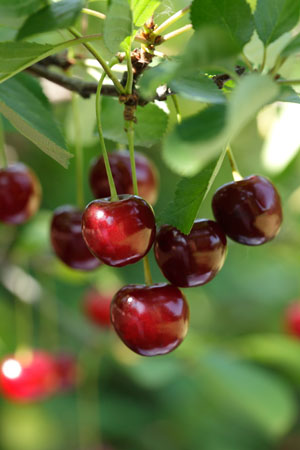Prunus avium; cerasus
|
Overview
 Libraries
The following libraries are associated with this organism.
Genomes
Links
Description
Prunus avium (sweet cherry) and P. cerasus (sour cherry) are thought to have originated in an area south of the Caucasian mountains and around the Caspian and Black Seas before being distributed throughout Europe and Russia by explorers. Cherry fruit are botanically classified as a drupe, with a small pit (endocarp). P. avium are diploid (2n = 16), while P. cerasus are tetraploid (2n = 4x = 32). Hybrids of P. avium × P. cerasus, known as Duke cherry, are tetraploids that are thought to originate from the pollination of P. cerasus by an unreduced gamete from P. avium. Self-fertile cherry cultivars exist in both P. avium and P. cerasus, although certain P. avium cultivars require cross-pollinators. Sweet cherries are large, red to black, with high sugars content, and have firm flesh, with varying color from light yellow to dark red color. There are two types of sour cherry, including Morello (dark-red juice) and Amarelle (lighter-red with colorless juice), with an acid taste and softer flesh than sweet cherry. The fruit of sweet cherries are highly prized in the marketplace and are consumed fresh or preserved, while sour cherries are primarily used for cooking, particularly pies, tarts, and as a syrup in certain types of liqueurs. Sour cherry juice has been shown to have anti-inflammatory properties. Both sweet and sour cherries are grafted on rootstocks. The major diseases of both sweet and sour cherries are powdery mildew (Podosphaera clandestine), cherry leaf spot (Blumeriella jaapii) Armillaria root rot (Armillaria spp), botrytis blossom blight, brown rot (Monilinia fruticola or M. laxa), and bacterial canker (Pseudomonas syringae). A number of viruses can affect tree growth, including Prunus Necrotic Ringspot Virus (PNRV), Prune Dwarf Virus (PDV) and Little cherry disease. There are resistant sources of germplasm for a number of these diseases and are a focus in many breeding programs worldwide. Transcripts
Below is a list of transcript assemblies that are available for Prunus persica. Click the assembly name for further details.
SNP Arrays
SNPs for cherry are available from the following:
|
